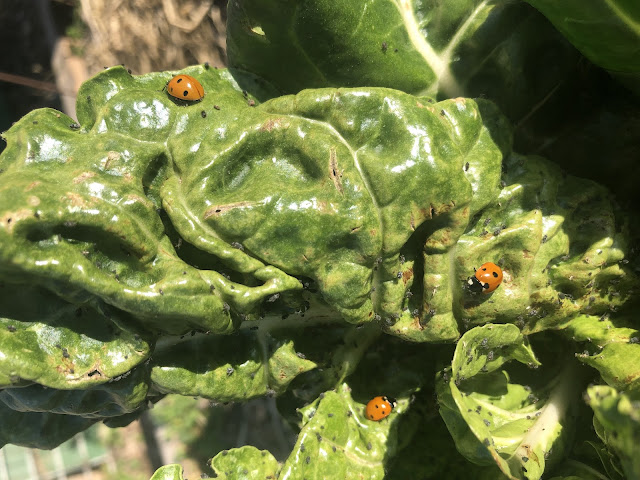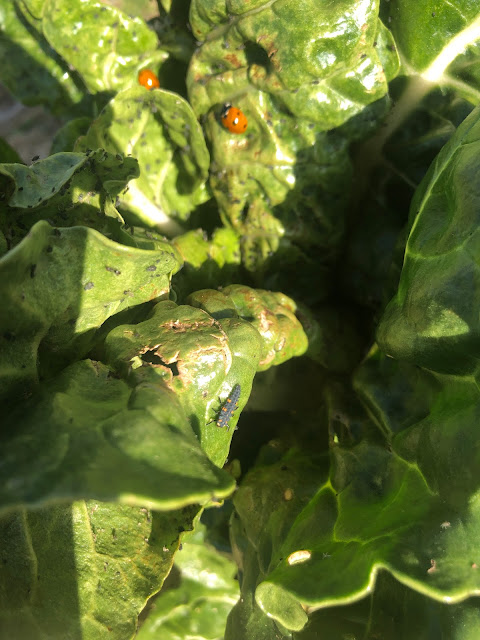
Aphids the meal of choice for the beloved beneficial insect

|
|
They dropped into Club Chard for a feast: Three of about a dozen sevenspotted lady beetles (
Coccinella septempunctata
)
were dining on aphids in my community garden plot. (Photos: Kathy Morrison)
|
If there were a "Trending Topics" list among gardeners right now, "Lady Beetles" (aka ladybugs) would be at the top.
The colorful and beloved insect is back in our gardens in a big way this spring, working hard for us by doing what comes naturally: Eating aphids.
Almost every conversation I've had lately with a fellow gardener has included a comment about "so many ladybugs!" It happened again Wednesday during the Open Garden at the Fair Oaks Horticulture Center, as the bright little beetles were easily seen among the fronds of the white yarrow ( Achillea millefolium ) that I was trimming. Visitors to the Herb Garden area spotted lady beetles on the Scarlet Unique geranium ( Pelargonium fulgidum ) and other plants nearby. Master gardeners had also seen quite a few in the orchard trees the previous week.
So, hurray for Mother Nature's beneficial predators!
But why so many this year? Are there more aphids attracting more lady beetles? Or are the conditions just right for the beneficials this year? Or are we simply more aware of the importance of biological controls?
It might be a combination of those factors, but cold does kill aphids, and we didn't have much cold this past winter. (Temperatures above 90 degrees also kill them, which is why aphids are less of a problem here during summer.) Moderate temperatures of 65 to 80 degrees are their ideal climate. More aphids available means more food for more lady beetles, who overwinter in protected areas.
What if your garden is full of aphids but hasn't yet become a home for lady beetles? Ideally, the garden should include plants that entice beneficials with nectar and habitat, then encourage them to stick around. Yarrow is a good one for spring, along with alyssum, lobelia, thyme, cornflower, calendula, geraniums and marigolds. Here's an excellent list of plants for all beneficials .

|
|
See that alligator-looking insect in the lower middle of the photo? That's
a lady beetle larva, aka voracious teenager. They eat even more
aphids than the adults do.
|
An easy way to fight aphids is to blast them off the plant with a strong spray of water. (Tip: Hold your free hand behind tender rosebuds to avoid blasting the buds off as well.) However, some gardeners try to buy containers of lady beetles and deposit them in the garden -- and then are mad when the insects fly off. Is this a commercial scam?
Well, no, but there are better and worse ways to handle the release of lady beetles. A blog post by UCANR's Mary Louise Flint tackles this question: "University of California research has demonstrated that lady beetle releases can effectively control aphids in a limited landscape or garden area if properly handled and applied in sufficient numbers." Note the "limited" and the "if," and take a look at the full blog post to learn how it can be done.
Here's another thing about those commercial lady beetles: They're not residents of the Central Valley flatlands. As Flint notes, "Lady beetles sold at nurseries for aphid control are convergent lady beetles, named for the converging white marks on its thorax. Suppliers collect beetles from large overwintering aggregations in California's foothills and mountains. Many other species of lady beetles occur naturally in California landscapes but don't aggregate in the mountains and aren't sold commercially."
And, psst, don't buy lady beetles that haven't been refrigerated at the store. Those room-temperature insects are active and climbing all over each other, resulting in a lot of casualties.
Even under the best circumstances, expect purchased lady beetles to fly away after a few days. Their mission accomplished, they're off to find more caches of yummy aphids. Or maybe just heading home.
(For more on lady beetles, check out this detailed and illustrated page from the UC Integrated Pest Management.)
Comments
0 comments have been posted.Sacramento Digs Gardening to your inbox.
Sites We Like
Garden Checklist for week of April 14
It's still not warm enough to transplant tomatoes directly in the ground, but we’re getting there.
* April is the last chance to plant citrus trees such as dwarf orange, lemon and kumquat. These trees also look good in landscaping and provide fresh fruit in winter.
* Smell orange blossoms? Feed citrus trees with a low dose of balanced fertilizer (such as 10-10-10) during bloom to help set fruit. Keep an eye out for ants.
* Apply slow-release fertilizer to the lawn.
* Thoroughly clean debris from the bottom of outdoor ponds or fountains.
* Spring brings a flush of rapid growth, and that means your garden needs nutrients. Fertilize shrubs and trees with a slow-release fertilizer. Or mulch with a 1-inch layer of compost.
* Azaleas and camellias looking a little yellow? If leaves are turning yellow between the veins, give them a boost with chelated iron.
* Trim dead flowers but not leaves from spring-flowering bulbs such as daffodils and tulips. Those leaves gather energy to create next year's flowers. Also, give the bulbs a fertilizer boost after bloom.
* Pinch chrysanthemums back to 12 inches for fall flowers. Cut old stems to the ground.
* Mulch around plants to conserve moisture and control weeds.
* From seed, plant beans, beets, cantaloupes, carrots, corn, cucumbers, melons, radishes and squash.
* Plant onion sets.
* In the flower garden, plant seeds for asters, cosmos, celosia, marigolds, salvia, sunflowers and zinnias.
* Transplant petunias, zinnias, geraniums and other summer bloomers.
* Plant perennials and dahlia tubers for summer bloom.
* Mid to late April is about the last chance to plant summer bulbs, such as gladiolus and tuberous begonias.
* Transplant lettuce seedlings. Choose varieties that mature quickly such as loose leaf.